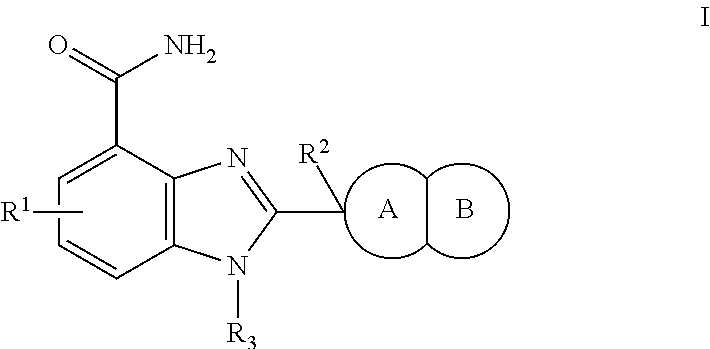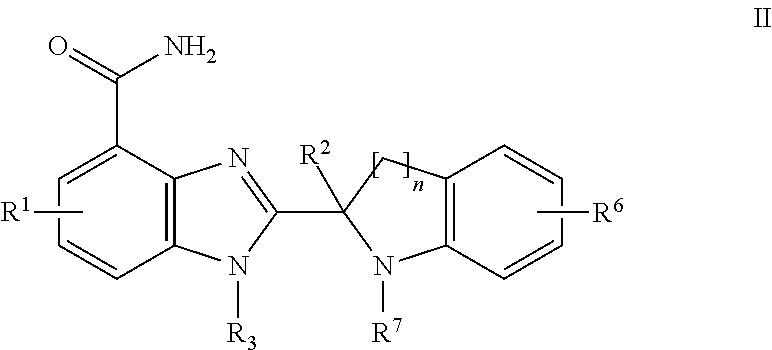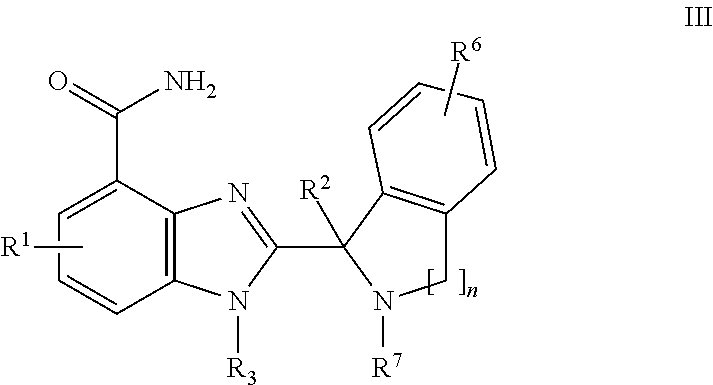Small molecule inhibitors of PARP activity
a small molecule, inhibitory technology, applied in the direction of drug composition, metabolic disorder, cardiovascular disorder, etc., can solve the problem that no endogenous effect has been shown to be detrimental to the health of ir injured tissues
- Summary
- Abstract
- Description
- Claims
- Application Information
AI Technical Summary
Benefits of technology
Problems solved by technology
Method used
Image
Examples
example 1
Benzyl 3-(4-carbamoyl-1H-benzo[d]imidazol-2-yl)-3,4-dihydroisoquinoline-2-(1H)-carboxylate
[0202]Step-1: To a solution of 2-((benzyloxy)carbonyl)-1,2,3,4-tetrahydroisoquinoline-3-carboxylic acid (1.0 g, 3.21 mmol) in anhydrous DMF (20 ml) was added EDC.HCl (1.85 g, 9.63 mmol), HOBt (681 mg, 5.05 mmol) and triethylamine (0.7 ml, 4.81 mmol) and the mixture was stirred at RT for 10 min. To this reaction mixture, 2,3-diaminobenzamide (606 mg, 4.01 mmol) was added and was stirred at RT over night. The reaction was poured in to water, stirred for 30 min and extracted with ethyl acetate. The organic layer was washed with brine and dried over anhydrous sodium sulfate and concentrated under vacuum to yield benzyl 3-(2-amino-3-carbomoylphenylcarbamoyl)-3,4-dihydroisoquinoline-2(1H)-carboxylate. MS (ES+): m / z 445.1 [M+H]+
[0203]Step-2: A solution of benzyl 3-(2-amino-3-carbomoylphenylcarbamoyl)-3,4-dihydroisoquinoline-2(1H)-carboxylate (1.3 g, 2.92 mmol) in acetic acid (20 ml) was heated to 80° ...
example 2
2-(1,2,3,4-Tetrahydroisoquinolin-3-yl)-1H-benzo[d]imidazole-4-carboxamide
[0204]To a solution of benzyl 3-(4-carbamoyl-1H-benzo[d]imidazol-2-yl)-3,4-dihydroisoquinoline-2-(1H)-carboxylate (400 mg, 0.938 mmol) in methanol (20 ml) was added 10% Pd / C (40 mg) and the reaction mixture was degassed and stirred under H2 at 1 atmosphere pressure for 2 h at RT. The reaction mixture was filtered and the filtrate was concentrated and the crude was product further triturated with ether to afford 2-(1,2,3,4-tetrahydroisoquinolin-3-yl)-1H-benzo[d]imidazole-4-carboxamide. MS (ES+): m / z 293.1 [M+H]+
example 3
Benzyl 2-(4-carbamoyl-1H-benzo[d]imidazol-2-yl)indoline-1-carboxylate
[0205]Step-1: To a solution of 1-((benzyloxy)carbonyl)indoline-2-carboxylic acid (1.0 g, 3.37 mmol) in anhydrous DMF (20 ml) was added EDC.HCl (1.93 g, 10.10 mmol), HOBt (681 mg, 5.05 mmol) and triethylamine (0.7 ml, 5.05 mmol) at RT and the mixture was stirred for 10 min. To this reaction mixture, 2,3-diaminobenzamide (635 mg, 4.20 mmol) was added and heated to 80° C. over night. The reaction mixture was poured into ice cold water and stirred for 30 min. The precipitate formed was filtered and dried under vacuum to yield benzyl 2-(2-amino-3-carbamoylphenylcarbamoyl) indoline-1-carboxylate. MS (ES+): m / z 431.1 [M+H]+
[0206]Step-2: A solution of benzyl 2-(2-amino-3-carbamoylphenylcarbamoyl) indoline-1-carboxylate (1.5 g, 3.48 mmol) in acetic acid (20 ml) was heated to 80° C. and stirred overnight. The reaction mixture was concentrated, neutralized with aq. NaHCO3 and extracted with DCM. The DCM layer was washed with ...
PUM
| Property | Measurement | Unit |
|---|---|---|
| mean survival time | aaaaa | aaaaa |
| temperature | aaaaa | aaaaa |
| pressure | aaaaa | aaaaa |
Abstract
Description
Claims
Application Information
 Login to View More
Login to View More - R&D
- Intellectual Property
- Life Sciences
- Materials
- Tech Scout
- Unparalleled Data Quality
- Higher Quality Content
- 60% Fewer Hallucinations
Browse by: Latest US Patents, China's latest patents, Technical Efficacy Thesaurus, Application Domain, Technology Topic, Popular Technical Reports.
© 2025 PatSnap. All rights reserved.Legal|Privacy policy|Modern Slavery Act Transparency Statement|Sitemap|About US| Contact US: help@patsnap.com



